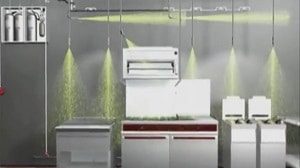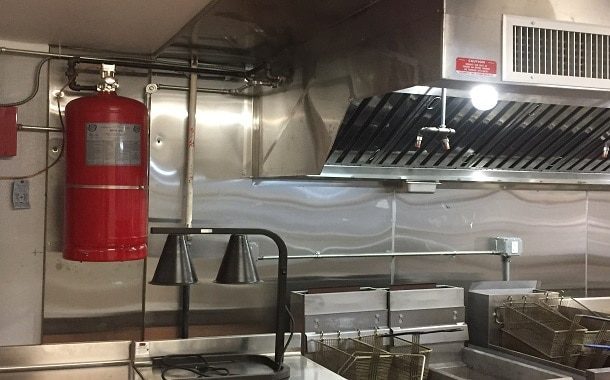How Much Do Commercial Kitchen Hood Fire Suppression Systems Cost?
Last Updated on March 7, 2024
Written by CPA Alec Pow | Content Reviewed by ![]() CFA Alexander Popinker
CFA Alexander Popinker
Restaurant and commercial kitchen fires pose immense and costly risks to businesses, with around 8,000 blazes sparking in commercial cooking facilities annually in the United States alone according to detailed NFPA fire data.
But what exactly is the typical cost range to expect for budgeting and installing a tailored fire suppression system for most restaurant or institutional kitchens?
Generally plan around spending anywhere from $3,000 on the very low end up to $12,000 or more on the highest end of the spectrum, with most average-sized restaurant kitchen systems falling in the range of $5,000 to $8,000 depending on several key factors including the overall size and configuration of the kitchen area being protected, the complexity of the cooking equipment involved, and the specific types of fire suppression components and design needed to provide full code-compliant coverage.
Highlights
- Typical installed costs range from $3,000 – $12,000+ based on kitchen size and scope of coverage/features
- Extensive commercial kitchens require customized engineered systems costing $7,000+ in most cases
- Size, specific layout, detection sophistication, monitoring all impact end pricing
- Maintenance and recharge costs are extra around $1,000+ per year
How Much Do Commercial Kitchen Hood Fire Suppression Systems Cost?
While numerous variables impact exact project pricing, some general cost ranges for a full turnkey hood fire suppression system would be:
Small to Medium Restaurant Kitchen Systems
For a fundamentally compliant fire suppression system protecting a relatively compact kitchen area approximately 10 feet to 20 feet wide, typically sufficient for lower volume single cookline cafes and family restaurants, installed costs often range from $3,000 on the very low end up to $7,000 on average.
This would provide basic coverage for a limited hood footprint using an entry-levelAnsul R-102 wet suppression agent tank matched with a single pulling manual activation switch and simple control panel connected to a handful of strategically placed nozzles.
Large Commercial Kitchen Fire Suppression Systems
In contrast, maximizing fire protection for an expansive open kitchen line spanning 30 feet to 50+ feet in length in order to safely handle cooking volumes from multiple ovens, fryers, grills, and other heavy cooking equipment – as is typical for larger restaurants, hotel venues, school cafeterias, hospitals, banquet halls or other institutions – requires a more complex engineered system with costs ranging from $7,000 on the low end up to $12,000 or more on the upper end.
Larger systems need increased suppression agent capacity through multiple tanks, an extensive network of piping and greater number of precisely placed nozzles, as well as more advanced controls like infrared sensors, thermal detectors, and smart electronic activation alongside 24/7 monitoring integration.
In general terms, larger and more cooking-intensive kitchens demand higher capacity, customized fire suppression systems carrying bigger price tags.
At Kitchensafe USA, a kitchen fire suppression system can cost on average $4,750, with prices ranging from $2,000 to $7,500. Specific systems like the Ansul R-102 range from $3,000 to $5,500.
Keystone Fire sells a wet chemical kitchen fire suppression system for a price between $4,000 to $6,000 for a single tank system, depending on the number of appliances to be protected.
At Industrial Fire, the cost of an ANSUL System, specifically the Ansul R-102, typically ranges from $3,000 to $5,500. Additional hoods can be priced between $6,500 and $7,500.
HoodMart offers Ansul Pre-Pipe Fire System Deluxe with prices ranging from $4,223.88 to $13,312.90 depending on the size and features of the system.
Custom designing a system specifically matched to unique kitchen layouts and equipment demands intensive planning by experienced specialists to provide full fire protection.
Additionally factoring in any expenses for permits, inspections of completed installation, or facility infrastructure modifications to support new suppression equipment adds incrementally to total project budgets.
Factors Impacting The Costs
Several important factors come into play when determining the total installed cost for any new commercial kitchen fire suppression system:
Type of Fire Suppression System – Wet chemical agent systems like Ansul are the predominant standard for commercial kitchen environments where controlling hot grease flareups is essential, whereas alternative gaseous suppression methods using CO2, foam or water sprinklers carry their own equipment cost implications based on required nozzles, storage tanks and specialized installation needs.
Overall Size and Configuration of the Kitchen Area Being Protected – In basic terms, longer and more complex cooking hood lines spanning larger footprint square footage, especially those requiring custom fabricated ducted vents, demand significantly increased capacity from the fire suppression system.
This necessitates larger agent tanks, more strategically placed discharge nozzles, more complex distribution piping runs, and overall more costly materials and labor for both installation and maintenance. Covering expansive or challenging kitchen layouts inflates costs.
Scope of Detection Systems and Activation Components – Opting for more sophisticated flame and heat detection such as infrared sensors, thermal imaging cameras, and smart electronic activation controls allows the suppression system to respond faster to incipient fire events but also carries a higher equipment and installation price tag versus more basic fusible link detectors and manual pull activation designs.
Integrated fire panels with remote monitoring capabilities also provide an extra layer of urgent emergency response but add to budgets as well.
Required Volume of Suppression Agent and Extent of Piping Distribution – Larger kitchens with more cooking equipment simply demand increased suppression agent capacity, which means larger storage tanks. This also requires extensive piping runs to reach all needed appliance coverage zones.
These material costs factor into total installed pricing significantly, along with associated labor time.
Add-On Equipment like Alarm and Monitoring Integration – While not strictly required, adding supplementary components like audible and visual alarms and connecting controls into central building alarm systems leverages the maximum capabilities of the suppression system and provides heightened urgent alerts. But integration and add-ons contribute to overall pricing.
Ongoing Maintenance Cost Factors
 Beyond just installation, properly maintaining commercial kitchen fire suppression systems in good working order through periodic professional servicing ensures they function reliably when needed most. Typical recurring standard costs include:
Beyond just installation, properly maintaining commercial kitchen fire suppression systems in good working order through periodic professional servicing ensures they function reliably when needed most. Typical recurring standard costs include:
Semi-Annual Inspection Services – NFPA standards mandate inspecting the entire suppression system at least twice annually, checking and testing components like fusible links, piping, triggering systems, nozzles, and more for any issues. Professional inspections commonly cost around $200 each on average.
Agent Tank Recharge Services – After any discharge of suppression agent during a fire event, the full tanks must be immediately recharged with fresh agent, which carries typical fees ranging from $100 or more depending on the volume needed. This maintains readiness.
Nozzle Jet Cleaning – If regular kitchen maintenance allows grease buildup in nozzles, flushing and cleaning services done every 6 months cost around $75 per nozzle depending on quantity and extent of blockages.
You might also like our articles about the cost of a commercial fire sprinkler system, a commercial fire alarm system, and a fire extinguisher ball.
Annual System Functionality Testing – Thorough testing annually by technicians ensures the control panel, triggering mechanisms, release valves, piping network, and nozzles activate appropriately under simulated fire conditions. Expect around $300 for comprehensive tests.
In total, most food service businesses should reasonably factor in around $1,000+ in annual maintenance expenses to properly care for and service their kitchen fire suppression equipment assets. Proper inspection and care provide peace of mind the system works as designed when an emergency strikes. Never cut corners on fire safety.
Frequently Asked Questions
What is a Type I Commercial Kitchen Exhaust Hood System?
Type I ventilation hoods are designed and certified for use over heavy cooking equipment producing significant grease fumes and smoke emissions, such as grills, fryers, ranges, stovetops, and commercial ovens. Because they vent grease-laden exhaust, Type 1 hoods are required by code to have integrated automatic fire suppression systems. These are the types you see in most active restaurants, cafeterias, and hotel kitchens.
Do Type 2 hoods need fire suppression?
Generally no. Type II ventilation hoods are installed over equipment producing relatively lighter steam, heat, and condensation emissions, not grease, such as dishwashers, kettles, steamers and braising pans. Since they handle lighter cooking loads versus Type I hoods, NFPA standards do not require integrating fire suppression into Type II hoods.
What is the difference between Type 1 and Type 2 commercial hoods?
The core differences are that Type I hoods have built-in grease filters and automatic heat activated fire protection systems suitable for heavy cooking, whereas Type II hoods lack suppression systems and suit lighter duty steaming and boiling equipment not producing grease. For busy restaurant kitchens, Type I hoods with suppression systems are much more common for protecting grills, fryers and other grease-releasing appliances from dangerous flare-ups.


How much does an 2.5 gallon range guard tank replacement cost with labor?